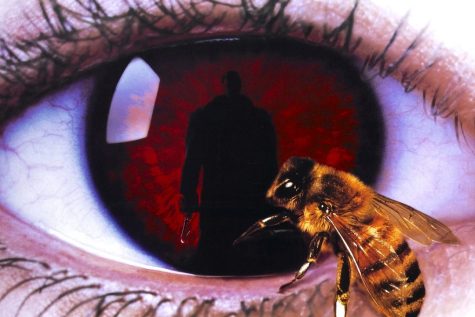‘Candyman’ puts scary spin on urban legend

There are many movies this time of year that can fill our craving for horror … and sweets …
A delightful starter is the 1992 classic “Candyman,” written by “Hellraiser” creator Clive Barker. It stars longtime actor Tony Todd and Virginia Madsen, who you may recognize as the love interest from the hit 2004 romantic comedy “Sideways.”
In “Candyman,” Madsen plays a graduate student, Helen, who is researching urban legends, and particularly one about a vengeful killer who haunts a Chicago housing project.
Helen and her college associates are skeptical of Candyman’s existence to begin with, but she quickly realizes for the Black residents of Cabrini-Green – one of Chicago’s most notorious projects – the killer is very real.
She follows leads about relatively recent murders attributed to the hundred-year-old spirit of Candyman, played by Todd.
The acting in this movie feels a little unbelievable at times, but in a delightful way. Viewers may only notice this in a couple instances.
There are some jump scares, and most of them are predictable but fun nonetheless. I was mostly riveted to the storyline, which is creative and progresses at a good rate up to the climactic scene. The editing is great because there are times where I wondered if I’m watching a dream sequence or if something’s really happening. The creators were able to pull it off, unlike some movies where being unable to tell is prolonged and muddled.
I did find one plot hole in the movie, which is innocuous to the story. Coincidentally, it is right before Helen crawls through a hole so perhaps it is intentional.
Candyman’s backstory originates from his tragic murder. Born the son of a former slave, Candyman was raised with the education and respect of his white peers. But they turn on him when he falls in love with a prominent white woman and conceives a baby with her.
The mob sawed off Candyman’s hand and dumped a swarm of bees on him, which stung him to death. (This is where the “sweet” connection comes in because bees like the taste of sugar.) After his human death, Candyman haunts the neighborhood where his ashes were strewn: Cabrini-Green.
Or does he?
A possible copycat might be on the loose, and Helen seeks to prove this. According to the legend, if one says Candyman’s name five times in a mirror, he will emanate from the adjacent unit behind the medicine cabinet – which is how he purportedly accessed his first victim due to the project’s cheap design.
Helen and a friend investigate the morbid unit which has fallen into disrepair, and with the help of a little boy and his mother, Helen is able to get within hooking distance of the killer.
Once Helen meets the Candyman, her world turns upside down as her sanity is questioned by the police and those around her at the university.
The Candyman wants Helen to be his next victim and haunts her until he gets what he wants. This puts Helen in a predicament because she is trying to rescue a baby Candyman will kill next.
While most might qualify this as a slasher movie, there are only a couple mild shots of gore. There is brief nudity and two disparaging terms used, so perhaps avoid watching this with younger members of the family.
I rate this movie a 5/5. With captivating cinematography and creepy music by Philip Glass, “Candyman” was a box office success that spawned two sequels in the 90s and a Jordan Peele extension released in 2021.
Edited by Glorianna Noland, LeSha’ Davis
Your donation will support the student journalists of Washburn University. Your contribution will allow us to purchase equipment and cover our annual website hosting costs.












